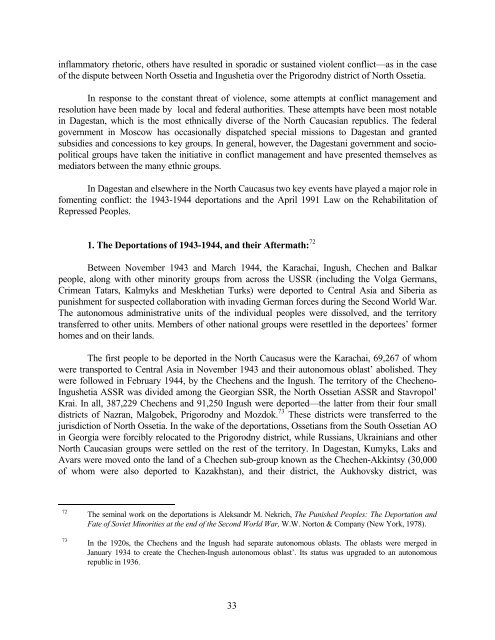RUSSIA'S TINDERBOX - Belfer Center for Science and International ...
RUSSIA'S TINDERBOX - Belfer Center for Science and International ...
RUSSIA'S TINDERBOX - Belfer Center for Science and International ...
Create successful ePaper yourself
Turn your PDF publications into a flip-book with our unique Google optimized e-Paper software.
inflammatory rhetoric, others have resulted in sporadic or sustained violent conflict—as in the case<br />
of the dispute between North Ossetia <strong>and</strong> Ingushetia over the Prigorodny district of North Ossetia.<br />
In response to the constant threat of violence, some attempts at conflict management <strong>and</strong><br />
resolution have been made by local <strong>and</strong> federal authorities. These attempts have been most notable<br />
in Dagestan, which is the most ethnically diverse of the North Caucasian republics. The federal<br />
government in Moscow has occasionally dispatched special missions to Dagestan <strong>and</strong> granted<br />
subsidies <strong>and</strong> concessions to key groups. In general, however, the Dagestani government <strong>and</strong> sociopolitical<br />
groups have taken the initiative in conflict management <strong>and</strong> have presented themselves as<br />
mediators between the many ethnic groups.<br />
In Dagestan <strong>and</strong> elsewhere in the North Caucasus two key events have played a major role in<br />
fomenting conflict: the 1943-1944 deportations <strong>and</strong> the April 1991 Law on the Rehabilitation of<br />
Repressed Peoples.<br />
1. The Deportations of 1943-1944, <strong>and</strong> their Aftermath: 72<br />
Between November 1943 <strong>and</strong> March 1944, the Karachai, Ingush, Chechen <strong>and</strong> Balkar<br />
people, along with other minority groups from across the USSR (including the Volga Germans,<br />
Crimean Tatars, Kalmyks <strong>and</strong> Meskhetian Turks) were deported to Central Asia <strong>and</strong> Siberia as<br />
punishment <strong>for</strong> suspected collaboration with invading German <strong>for</strong>ces during the Second World War.<br />
The autonomous administrative units of the individual peoples were dissolved, <strong>and</strong> the territory<br />
transferred to other units. Members of other national groups were resettled in the deportees’ <strong>for</strong>mer<br />
homes <strong>and</strong> on their l<strong>and</strong>s.<br />
The first people to be deported in the North Caucasus were the Karachai, 69,267 of whom<br />
were transported to Central Asia in November 1943 <strong>and</strong> their autonomous oblast’ abolished. They<br />
were followed in February 1944, by the Chechens <strong>and</strong> the Ingush. The territory of the Checheno-<br />
Ingushetia ASSR was divided among the Georgian SSR, the North Ossetian ASSR <strong>and</strong> Stavropol’<br />
Krai. In all, 387,229 Chechens <strong>and</strong> 91,250 Ingush were deported—the latter from their four small<br />
districts of Nazran, Malgobek, Prigorodny <strong>and</strong> Mozdok. 73 These districts were transferred to the<br />
jurisdiction of North Ossetia. In the wake of the deportations, Ossetians from the South Ossetian AO<br />
in Georgia were <strong>for</strong>cibly relocated to the Prigorodny district, while Russians, Ukrainians <strong>and</strong> other<br />
North Caucasian groups were settled on the rest of the territory. In Dagestan, Kumyks, Laks <strong>and</strong><br />
Avars were moved onto the l<strong>and</strong> of a Chechen sub-group known as the Chechen-Akkintsy (30,000<br />
of whom were also deported to Kazakhstan), <strong>and</strong> their district, the Aukhovsky district, was<br />
72 The seminal work on the deportations is Aleks<strong>and</strong>r M. Nekrich, The Punished Peoples: The Deportation <strong>and</strong><br />
Fate of Soviet Minorities at the end of the Second World War, W.W. Norton & Company (New York, 1978).<br />
73 In the 1920s, the Chechens <strong>and</strong> the Ingush had separate autonomous oblasts. The oblasts were merged in<br />
January 1934 to create the Chechen-Ingush autonomous oblast’. Its status was upgraded to an autonomous<br />
republic in 1936.<br />
33
















